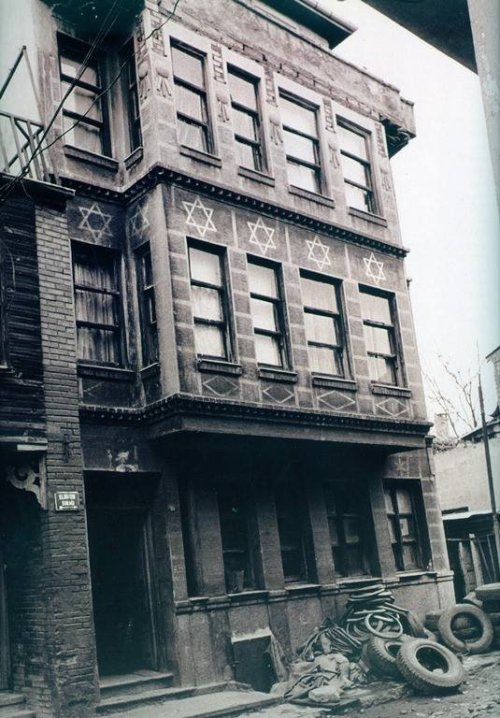#sephardic


Souvenir de Salonique : Rue Parallèle au quai DS 135 .G72 T41 S688 1912
“Newly acquired and cataloged for our Jewish Salonica Postcard Collection, this historical postcard depicts a street parallel to the dock in Salonica (Thessaloniki), circa April 1912.” Read more!


Les siècles se rencontrant : Juives : La mère et la fille. DS 135 .G72 M47 C67 1917
Newly catalogued for the Jewish Salonica Postcard Collection: Two centuries meeting – the mother and daughter, circa 1917.
“A mother and her daughter walk down a street in Salonica (Thessaloniki, Greece) around 1917, as depicted in this historical postcard newly cataloged and added to our Jewish Salonica Postcard Collection. The mother is in a traditional Jewish dress while the daughter wears a modern Parisian one.”


Salonicco : Cimitero Israelita DS 135 .G72 T41 C46 1917
“With more than 300,000 graves, the Jewish cemetery of Salonica (Thessaloniki, Greece) depicted in this postcard was one of the largest Jewish cemeteries in Europe. This cemetery was also an outstanding symbol of the centuries-old Jewish presence in the Balkan port-city and capital of the region known as Macedonia – grave stones that have survived are dated back to 1493.
Initially located in the periphery of Salonica, the Jewish cemetery eventually became a central area as the city expanded eastward. After the Great Fire of 1917, new urbanistic plans proposed the expropriation or transfer of the cemetery. In the 1930s, parts of the Jewish necropolis were given to the University of Thessaloniki…” Read more!

Salonique 1917: Le Quartier israëlite détruit. Special Collections Research Center DS 135 .G72 T41 Q37 1917


Salonique: Incendie des 18-19-20 Août 1917 DS 135 .G72 T41 I53 1917
“Located between the Mediterranean Sea and the Balkan Peninsula, the port city of Salonica (Thessaloniki), Greece, is in the intersection of two different climatic zones – a geographic situation that creates high variations in atmospheric pressure during the year. In several occasions through the centuries, the strong winds that blow from the north down the Vardar valley whipped up fires that quickly spread, causing significant damage and devastation in the city. The fire that sparked in Salonica on Saturday, August 18, 1917 was of unprecedent scale and changed completely the physiognomy of the city. The fire burned a large part of the historic city center, where several predominantly Jewish neighborhoods were located, leaving a large part of the city’s population homeless – approximately 56,000 Jews, 15,000 Christians, and 10.000 Muslims had their houses consumed by the fire. After the fire, a new urbanistic plan was implemented under the leadership of two famous architects, Ernest Hébrard of France and Thomas Mawson of England. The majority of the Jewish residents who lost their houses, now impoverished, were transferred to peripheral areas of the town, such as the Regie Vardar and Campbell districts. Dozens of postcards depicted the great fire of 1917, including the two featured here, which were purchased by the Special Collections Research Center with the generous support of the Lucius N. Littauer Foundation and the Solovy Judaica Book Fund.” Read more!


• progress •

she’s back

Happy Hanukkah to all!
My friend Arnon Shorr made a really cool film about Jewish pirates in the 16th century Carribean. I got to make the poster. The Pirate Captain Toledano debuts at the Los Angeles Jewish Film Festival on May 2 (tickets here). If you want to see a movie inspired by true but mostly unknown Jewish history–and see Sephardi Jews on screen–look out for this film when it comes to a film festival near you.
Post link
I must admit to a slight obsession with culinary historian Michael W. Twitty (“…’kosher soul-rolls’— spring rolls stuffed with collared greens and pastrami — and Senegalese chicken soup featuring matzah balls and peanut butter….”!!! I want to eat that!), who’s forthcoming book,The Cooking Gene: A Journey through African-American Culinary History in the Old South, documents his personal “Southern Discomfort Tour” to explore the complex food culture in the American South/African Diaspora. The Cooking Gene is available for pre-order and comes out in August. -Alisa, Assistant Curator
…One memory, of his African-American ancestors in the South, seems obvious. The other, of Jews enslaved thousands of years ago in Egypt, perhaps less so.
…
“How I became Jewish began through food,” Twitty told JTA during an interview in the lobby of a trendy New York hotel. His Christian mother, whom Twitty describes in his book as “the best challah braider I have ever known,” introduced him to the Shabbat staple early on. At the age of 7, Twitty, who grew up in the suburbs of Washington, D.C., declared himself to be Jewish.
“[T]here are some things that science cannot explain, it’s a calling, it’s a connection, it’s above us,” Twitty said of his childhood interest in Judaism.
Food continued to inform his Jewish journey, which culminated in his conversion at 25. He chose a Sephardi Mizrahi synagogue because he found it the most welcoming as a person of color — and because of its culinary traditions.
“[T]he food was better — and [you can eat] rice on Pesach,” he said, referring to the Sephardi custom of eating rice and other legumes from which Ashkenazic Jews abstain during Passover.
Asked to describe himself, Twitty invents a new word: “Afro-ashke-phardi.”
“I feel African-American brings in the Southern, brings in the mixture of heritage that is African-American and African diaspora,” he said. “I feel like the Ashkenazi, I really do appeal to Hasidic culture, dabbled with it before in my life. And Sephardic and Mizrahi heritage will always be a part of me because it’s where I converted, in a Sephardic and Mizrahi synagogue.”
The kitchen also served as a place for Twitty to discover another identity: as a gay man.
“There was a lot of gay culture in our kitchen,” Twitty writes, citing the show tunes that family members would play while cooking. The kitchen was also the place where he first came out to his mother and aunt.
Twitty’s background is reflected in his unique takes on traditional Jewish food. A Shabbat dinner at his house might include such dishes as “kosher soul-rolls”— spring rolls stuffed with collared greens and pastrami — and Senegalese chicken soup featuring matzah balls and peanut butter….
Read more here: https://www.jta.org/2017/05/24/life-religion/how-this-african-american-jew-uses-cooking-to-fuse-his-two-identities




